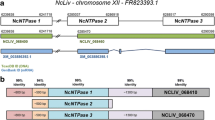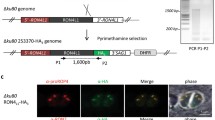Abstract
Neospora caninum, an Apicomplexa parasite, is the causative agent of neosporosis. As described for other members of Apicomplexa, microneme proteins (MICs) play a key role in attachment and invasion of host cells by N. caninum. Herein we identified N. caninum microneme protein 6 (NcMIC6) that is orthologous to Toxoplasma gondii microneme protein 6 (TgMIC6). The open reading frame of the NcMIC6 gene is 984 bp and encodes a 327 amino acid peptide. Sequence analysis showed that NcMIC6 included a signal peptide, a transmembrane region, three epidermal growth factor-like (EGF) domains, and two low complexity regions. Antibodies raised against recombinant NcMIC6 recognized an approximately 35-kDa native MIC6 protein in Western blots of N. caninum tachyzoites. Immunofluorescence analysis showed that NcMIC6 had a polar labeling pattern, which was consistent with localization of micronemes in the apical region. Pulse invasion assays showed that NcMIC6 translocated from the apical tip to the posterior end of the parasites. Secretion assays demonstrated that NcMIC6 was released into the supernatants. Importantly, it was clearly revealed by co-immunoprecipitation that NcMIC6 formed a complex with other two soluble microneme proteins (NcMIC1 and NcMIC4). In conclusion, identification and characterization of the novel microneme protein NcMIC6 may contribute to understanding how this protein functions during the parasite motility and host cell invasion.





Similar content being viewed by others
References
Alexander DL, Mital J, Ward GE, Bradley P, Boothroyd JC (2005) Identification of the moving junction complex of Toxoplasma gondii: a collaboration between distinct secretory organelles. PLoS Pathog 1, e17
Brecht S, Carruthers VB, Ferguson DJ, Giddings OK, Wang G, Jakle U, Harper JM, Sibley LD, Soldati D (2001) The toxoplasma micronemal protein MIC4 is an adhesin composed of six conserved apple domains. J Biol Chem 276:4119–4127
Bumstead J, Tomley F (2000) Induction of secretion and surface capping of microneme proteins in Eimeria tenella. Mol Biochem Parasitol 110:311–321
Carruthers V, Boothroyd JC (2007) Pulling together: an integrated model of Toxoplasma cell invasion. Curr Opin Microbiol 10:83–89
Carruthers VB, Sibley LD (1997) Sequential protein secretion from three distinct organelles of Toxoplasma gondii accompanies invasion of human fibroblasts. Eur J Cell Biol 73:114–123
Carruthers VB, Sibley LD (1999) Mobilization of intracellular calcium stimulates microneme discharge in Toxoplasma gondii. Mol Microbiol 31:421–428
Carruthers VB, Moreno SN, Sibley LD (1999) Ethanol and acetaldehyde elevate intracellular [Ca2+] and stimulate microneme discharge in Toxoplasma gondii. Biochem J 342(Pt 2):379–386
Davis CG (1990) The many faces of epidermal growth factor repeats. New Biol 2:410–419
Dubey JP (2003) Review of Neospora caninum and neosporosis in animals. Korean J Parasitol 41:1–16
Dubey JP, Lindsay DS (1996) A review of Neospora caninum and neosporosis. Vet Parasitol 67:1–59
Dubey JP, Schares G, Ortega-Mora LM (2007) Epidemiology and control of neosporosis and Neospora caninum. Clin Microbiol Rev 20:323–367
El Hajj H, Papoin J, Cerede O, Garcia-Reguet N, Soete M, Dubremetz JF, Lebrun M (2008) Molecular signals in the trafficking of Toxoplasma gondii protein MIC3 to the micronemes. Eukaryot Cell 7:1019–1028
Harper JM, Huynh MH, Coppens I, Parussini F, Moreno S, Carruthers VB (2006) A cleavable propeptide influences Toxoplasma infection by facilitating the trafficking and secretion of the TgMIC2-M2AP invasion complex. Mol Biol Cell 17:4551–4563
Hehl AB, Lekutis C, Grigg ME, Bradley PJ, Dubremetz JF, Ortega-Barria E, Boothroyd JC (2000) Toxoplasma gondii homologue of plasmodium apical membrane antigen 1 is involved in invasion of host cells. Infect Immun 68:7078–7086
Hoff EF, Cook SH, Sherman GD, Harper JM, Ferguson DJ, Dubremetz JF, Carruthers VB (2001) Toxoplasma gondii: molecular cloning and characterization of a novel 18-kDa secretory antigen, TgMIC10. Exp Parasitol 97:77–88
Huynh MH, Rabenau KE, Harper JM, Beatty WL, Sibley LD, Carruthers VB (2003) Rapid invasion of host cells by Toxoplasma requires secretion of the MIC2-M2AP adhesive protein complex. EMBO J 22:2082–2090
Keller N, Naguleswaran A, Cannas A, Vonlaufen N, Bienz M, Bjorkman C, Bohne W, Hemphill A (2002) Identification of a Neospora caninum microneme protein (NcMIC1) which interacts with sulfated host cell surface glycosaminoglycans. Infect Immun 70:3187–3198
Keller N, Riesen M, Naguleswaran A, Vonlaufen N, Stettler R, Leepin A, Wastling JM, Hemphill A (2004) Identification and characterization of a Neospora caninum microneme-associated protein NcMIC4 that exhibits unique lactose-binding properties. Infect Immun 72:4791–4800
Ling IT, Ogun SA, Momin P, Richards RL, Garcon N, Cohen J, Ballou WR, Holder AA (1997) Immunization against the murine malaria parasite Plasmodium yoelii using a recombinant protein with adjuvants developed for clinical use. Vaccine 15:1562–1567
Lourenco EV, Pereira SR, Faca VM, Coelho-Castelo AA, Mineo JR, Roque-Barreira MC, Greene LJ, Panunto-Castelo A (2001) Toxoplasma gondii micronemal protein MIC1 is a lactose-binding lectin. Glycobiology 11:541–547
Lovett JL, Howe DK, Sibley LD (2000) Molecular characterization of a thrombospondin-related anonymous protein homologue in Neospora caninum. Mol Biochem Parasitol 107:33–43
Meissner M, Reiss M, Viebig N, Carruthers VB, Toursel C, Tomavo S, Ajioka JW, Soldati D (2002) A family of transmembrane microneme proteins of Toxoplasma gondii contain EGF-like domains and function as escorters. J Cell Sci 115:563–574
Moreno SN, Zhong L (1996) Acidocalcisomes in Toxoplasma gondii tachyzoites. Biochem J 313:655–659
Naguleswaran A, Cannas A, Keller N, Vonlaufen N, Schares G, Conraths FJ, Bjorkman C, Hemphill A (2001) Neospora caninum microneme protein NcMIC3: secretion, subcellular localization, and functional involvement in host cell interaction. Infect Immun 69:6483–6494
Naguleswaran A, Cannas A, Keller N, Vonlaufen N, Bjorkman C, Hemphill A (2002) Vero cell surface proteoglycan interaction with the microneme protein NcMIC3 mediates adhesion of Neospora caninum tachyzoites to host cells unlike that in Toxoplasma gondii. Int J Parasitol 32:695–704
Rabenau KE, Sohrabi A, Tripathy A, Reitter C, Ajioka JW, Tomley FM, Carruthers VB (2001) TgM2AP participates in Toxoplasma gondii invasion of host cells and is tightly associated with the adhesive protein TgMIC2. Mol Microbiol 41:537–547
Reiss M, Viebig N, Brecht S, Fourmaux MN, Soete M, Di Cristina M, Dubremetz JF, Soldati D (2001) Identification and characterization of an escorter for two secretory adhesins in Toxoplasma gondii. J Cell Biol 152:563–578
Saouros S, Sawmynaden K, Marchant J, Simpson P, Matthews S (2008) Complete resonance assignment of the galectin-like domain of MIC1 from Toxoplasma gondii in complex with the second EGF domain from MIC6 and the backbone assignment in complex with the third EGF domain. Biomol NMR Assign 2:175–177
Sawmynaden K, Saouros S, Marchant J, Simpson P, Matthews S (2008) Complete NMR assignments for the second EGF domain of MIC6 from Toxoplasma gondii and re-assignment in complex with the galectin-like domain of MIC1. Biomol NMR Assign 2:187–189
Sheiner L, Santos JM, Klages N, Parussini F, Jemmely N, Friedrich N, Ward GE, Soldati D (2010) Toxoplasma gondii transmembrane microneme proteins and their modular design. Mol Microbiol 77:912–929
Sonda S, Fuchs N, Gottstein B, Hemphill A (2000) Molecular characterization of a novel microneme antigen in Neospora caninum. Mol Biochem Parasitol 108:39–51
Sultan AA, Thathy V, Frevert U, Robson KJ, Crisanti A, Nussenzweig V, Nussenzweig RS, Menard R (1997) TRAP is necessary for gliding motility and infectivity of plasmodium sporozoites. Cell 90:511–522
Tranas J, Heinzen RA, Weiss LM, McAllister MM (1999) Serological evidence of human infection with the protozoan Neospora caninum. Clin Diagn Lab Immunol 6:765–767
Tyler JS, Treeck M, Boothroyd JC (2011) Focus on the ringleader: the role of AMA1 in apicomplexan invasion and replication. Trends Parasitol 27:410–420
Vieira MC, Moreno SN (2000) Mobilization of intracellular calcium upon attachment of Toxoplasma gondii tachyzoites to human fibroblasts is required for invasion. Mol Biochem Parasitol 106:157–162
Yin J, Qu G, Cao L, Li Q, Fetterer R, Feng X, Liu Q, Wang G, Qi D, Zhang X, Miramontes E, Jenkins M, Zhang N, Tuo W (2012) Characterization of Neospora caninum microneme protein 10 (NcMIC10) and its potential use as a diagnostic marker for neosporosis. Vet Parasitol 187:28–35
Zhang H, Compaore MK, Lee EG, Liao M, Zhang G, Sugimoto C, Fujisaki K, Nishikawa Y, Xuan X (2007) Apical membrane antigen 1 is a cross-reactive antigen between Neospora caninum and Toxoplasma gondii, and the anti-NcAMA1 antibody inhibits host cell invasion by both parasites. Mol Biochem Parasitol 151:205–212
Acknowledgments
This study was supported by the “National Key Basic Research Program (973 program) of China” (2015CB150300), Beijing Municipal Natural Science Foundation (6131001), National Natural Science Foundation of China (31302075), and Modern Agroindustry Technology Research System (CARS-37).
Author information
Authors and Affiliations
Corresponding author
Rights and permissions
About this article
Cite this article
Li, W., Liu, J., Wang, J. et al. Identification and characterization of a microneme protein (NcMIC6) in Neospora caninum . Parasitol Res 114, 2893–2902 (2015). https://doi.org/10.1007/s00436-015-4490-3
Received:
Accepted:
Published:
Issue Date:
DOI: https://doi.org/10.1007/s00436-015-4490-3




